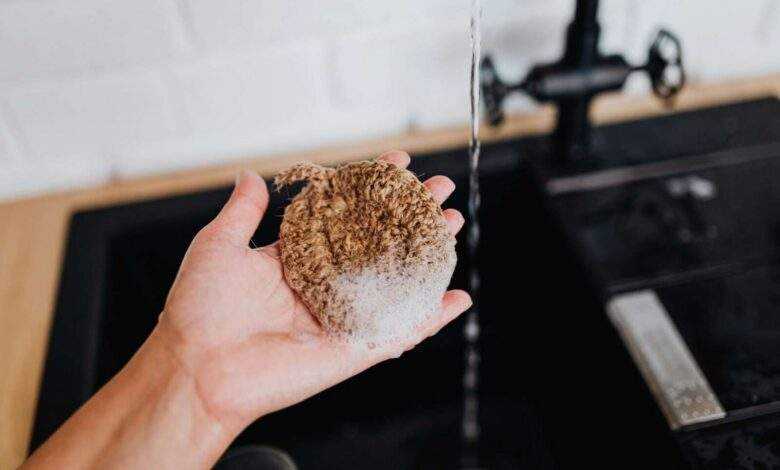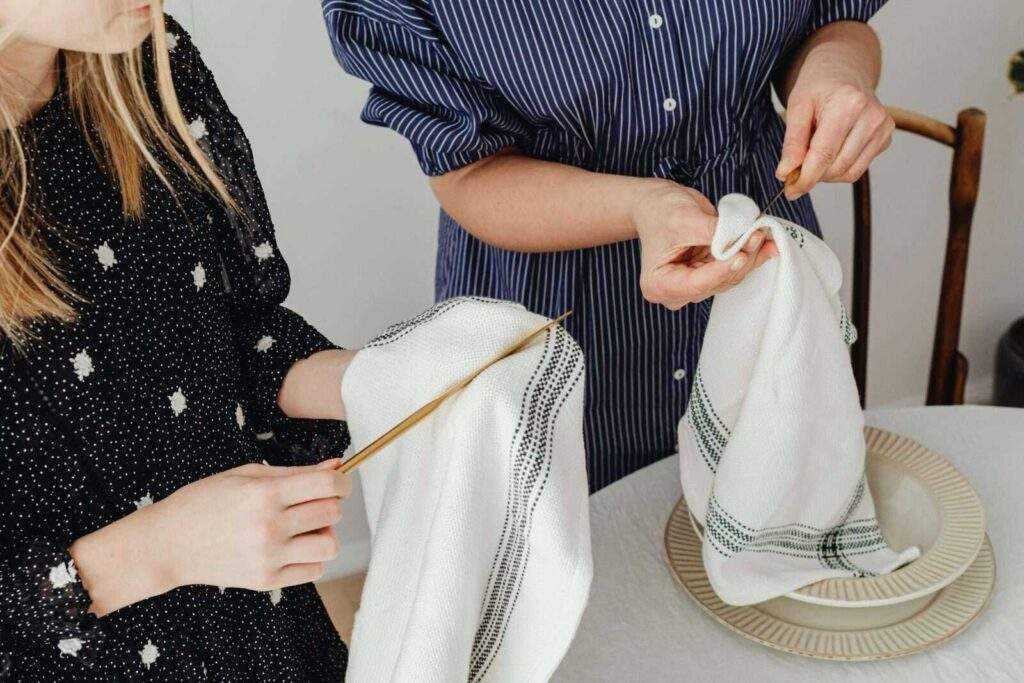Spice Up Your Kitchen with DIY Dish Cloths and Scrubbers

Table of Contents
Tired of that never-ending roll of paper towels disappearing before your eyes? Feeling a pang of guilt every time you toss one away? Well, get ready to ditch the disposable and say hello to a more sustainable, personalized approach to cleaning your kitchen! This guide unlocks the world of DIY dish cloths and scrubbers, empowering you to create functional and stylish cleaning tools that are kind to your wallet and the planet.
No matter your crafting experience, we’ve got you covered. From beginner-friendly sewing projects to whimsical crocheted designs, this guide offers a variety of options to unleash your inner artist. We’ll guide you through every step, from gathering eco-friendly materials to caring for your finished creations.
Get ready to discover the joy of crafting something beautiful and useful “waste” not! These DIY dish cloths and scrubbers are more than just cleaning tools – they’re a statement of your commitment to sustainability. So, grab your scissors, crochet hooks, or knitting needles, and let’s embark on a journey towards a cleaner kitchen and a greener future, one stitch at a time!
Kicking the Paper Towel Habit: Why Go DIY?
A. The Mounting Waste Problem
Paper towels are a major contributor to landfill waste, with the average American using approximately 2,400 to 3,000 paper towels each year just at home. The environmental impact is significant, from deforestation for raw materials to the energy and water used in production, and finally, the waste generated by disposable paper towels. According to the Environmental Protection Agency (EPA), paper and paperboard products, including paper towels, make up the largest portion of municipal solid waste.
- Deforestation: The production of paper towels requires large quantities of trees. Approximately 17 trees are cut down to produce one ton of paper towels.
- Water and Energy Use: The production process consumes vast amounts of water and energy, contributing to resource depletion and greenhouse gas emissions.
- Waste Management: Disposed paper towels contribute to landfill overflows and the release of methane, a potent greenhouse gas.
Visual resources: WWF, Greenpeace.
B. The Power of Reusables
Reusable dish cloths and scrubbers offer an eco-friendly alternative to paper towels, helping reduce waste and save money. Reusable options can last for months or even years, significantly reducing the need for disposables.
- Environmental Benefits: Reusables decrease the volume of waste sent to landfills and the demand for new resources. They also reduce the carbon footprint associated with the production, transportation, and disposal of paper towels.
- Economic Benefits: While there is an initial investment in materials, reusable cloths and scrubbers save money over time. A single cloth can replace hundreds of paper towels.
- Health Benefits: Natural fibers used in DIY projects are free from the chemicals often found in commercial cleaning products, making them safer for use around food and family members.
Inspiration sources: Pinterest, Etsy, Zero Waste Home, Trash is for Tossers.
C. The Thrifty Advantage
Creating your own dish cloths and scrubbers is not only sustainable but also cost-effective. By investing in a few materials, you can save money in the long run compared to the continuous expense of buying disposable paper towels.
- Cost Breakdown: Consider the cost of materials like cotton fabric or yarn versus the ongoing cost of purchasing paper towels. For example, a roll of paper towels costs around $1.50 and might last a week. In contrast, $10 spent on fabric or yarn can produce several reusable cloths that last for years.
- Long-Term Savings: Over a year, the savings from using reusable cloths can be substantial, especially in a busy household.
Budget-friendly tips: ThriftyFun, The Simple Dollar.

Crafting Essentials: Gathering Your Supplies
A. Fabric Fundamentals
Selecting the right fabric is crucial for creating effective and durable dish cloths and scrubbers.
- Absorbency: Cotton, flannel, and linen are highly absorbent, making them ideal for dish cloths. They are also easy to clean and maintain.
- Durability: Choose fabrics that can withstand frequent washing and scrubbing. Natural fibers like loofah and sisal are excellent for scrubbers due to their abrasive texture.
- Eco-Friendly Options: Look for organic or recycled materials to further reduce your environmental impact.
Recommended sources for fabrics: Organic Cotton Plus, Etsy.
B. Tools of the Trade
Different crafting methods require specific tools.
- Sewing Tools: Scissors, sewing needles, thread, measuring tape, and a cutting mat. For machine sewing, a sewing machine and appropriate needles are necessary.
- Crocheting Tools: Crochet hooks of various sizes, yarn needles for weaving in ends, and stitch markers.
- Knitting Tools: Knitting needles, yarn needles, stitch markers, and a row counter.
- Upcycling Tools: Old sweaters for yarn, fabric scraps, or other repurposed materials.
Resourceful crafting guides: Sewing.com, Crochet.com.
C. A Sustainable Mindset
When gathering supplies, prioritize eco-friendly and sustainable options.
- Organic Fabrics: Choose organic cotton, bamboo, or hemp fabrics.
- Recycled Yarn: Look for yarn made from recycled materials or repurpose yarn from old garments.
- Natural Cleaning Solutions: Use eco-friendly detergents and cleaning solutions to maintain your cloths and scrubbers.
Eco-friendly supplies: EcoRoots, Package Free Shop.

Dive into DIY: Project Ideas for Everyone
A. Sew Simple Dish Cloths (Beginner-Friendly)
Creating simple dish cloths is a great project for beginners. Here’s a step-by-step guide:
- Materials: Cotton or flannel fabric, scissors, sewing needle, thread.
- Cutting: Cut the fabric into 10×10 inch squares.
- Stitching: Fold the edges inward by 1/4 inch and stitch around to prevent fraying.
- Hanging Loop: Attach a small loop of fabric at one corner for hanging.
For visual instructions: Sewing.org.
B. Crafty Crochet (For the Experienced)
Crocheting dish cloths offers a creative and functional project for those with crochet experience. Here’s how to get started:
- Materials: Cotton yarn, crochet hook (size G or H recommended).
- Basic Pattern: Chain 30 stitches to start.
- Stitching: Single crochet across each row until the cloth measures about 10×10 inches.
- Finishing: Add a decorative edge with contrasting yarn for a personalized touch.
For patterns and tutorials: Ravelry, YouTube.
C. Knitting for Cleanliness (Intermediate Skill Level)
Knitting dish cloths is both practical and relaxing. Follow these steps for a simple project:
- Materials: Cotton yarn, knitting needles (size 7 or 8 recommended).
- Basic Pattern: Cast on 30 stitches.
- Stitching: Knit in garter stitch (knit every row) until the cloth measures about 10×10 inches.
- Finishing: Bind off and weave in the ends.
For knitting help: KnittingHelp, Lion Brand Yarn.
D. Scrubtastic Creations: Natural Scrubbers (All Skill Levels)
Natural scrubbers can be made from loofah, sisal, or coconut coir.
- Materials: Loofah, sisal rope, needle, and thread.
- Cutting: Cut the loofah into manageable pieces.
- Assembly: Sew the pieces together to create a scrubber pad. For sisal or coir, crochet or weave them into a pad shape.
For more ideas: Etsy, Instructables.
E. Bonus Project: Upcycled Magic (Optional)
Upcycle old towels or t-shirts into reusable dish cloths.
- Materials: Old towels or t-shirts, scissors, sewing needle, thread.
- Cutting: Cut the fabric into 10×10 inch squares.
- Stitching: Fold the edges inward by 1/4 inch and stitch around to prevent fraying.
Upcycling ideas: Upcycle That, Recyclart.

Beyond the Basics: Embellishments and Personalization
A. A Touch of Flair
Personalize your dish cloths with decorative touches:
- Embroidery: Add simple stitches or intricate designs to enhance the look.
- Fabric Paints: Use fabric paints or textile markers to create playful designs or monograms.
- Crocheted Details: Add a crocheted border or motifs for added flair.
For embroidery patterns: DMC. For fabric paints: Tulip Color.
B. Gifting with a Green Heart
Handmade dish cloths make thoughtful and eco-friendly gifts. Personalize them with specific color schemes or messages for special occasions, promoting sustainability and reducing reliance on disposable products.
Gifting ideas: Etsy, Pinterest.
The Care and Keeping of Your Creations
A. Washing Woes? Not Anymore!
Proper care ensures the longevity of your dish cloths and scrubbers.
- Washing: Use warm water and mild detergent. Avoid bleach, as it can weaken natural fibers.
- Stain Removal: Treat stains promptly with natural stain removers like baking soda or lemon juice.
- Mildew Prevention: Allow cloths to dry thoroughly between uses to prevent mildew.
For natural cleaning solutions: DIY Natural.
B. Air It Out: Drying Tips
Proper drying is essential to prevent bacteria growth and extend the life of your cleaning tools.
- Air Drying: Hang cloths to dry in a well-ventilated area.
- Avoid Heat: Do not dry them near heat sources, as this can damage the fibers.
- Alternative Methods: Use a dish rack or a dedicated drying line.
C. Knowing When to Say Goodbye
Replace worn-out or damaged dish cloths and scrubbers to maintain hygiene.
- Signs of Wear: Fraying edges, thinning fabric, or persistent odors indicate it’s time to replace.
- Repurposing: Use old cloths for other cleaning tasks like wiping down surfaces or cleaning the car.
For repurposing ideas: Earth911.

Troubleshooting Your DIY Journey
A. Sewing Slip-ups
Common sewing mistakes and how to fix them:
- Uneven Stitches: Practice basic stitches and use a consistent stitch length.
- Frayed Edges: Fold and stitch the edges to prevent fraying.
For sewing tips: Sewing.org.
B. Crocheting Conundrums
Troubleshooting crocheting issues:
- Dropped Stitches: Use stitch markers to keep track of your progress.
- Uneven Tension: Practice maintaining a consistent tension throughout your project.
For crochet help: YouTube.
C. Knitting Knots
Fix common knitting mistakes:
- Dropped Stitches: Use stitch markers and follow patterns carefully.
- Uneven Rows: Count stitches regularly to ensure consistency.
For knitting help: KnittingHelp.
Embrace the Sustainable Lifestyle: The Bigger Picture
A. More Than Just Clean Dishes
Expand your sustainable efforts beyond dish cloths:
- Reusable Cleaning Wipes: Make wipes from old fabric scraps.
- Natural Sponges: Use materials like sea sponges or loofah.
- DIY Cleaning Solutions: Use vinegar, baking soda, and essential oils for all-purpose cleaners.
For more DIY cleaning ideas: DIY Natural, Good Housekeeping.
B. A Community of Eco-Conscious Crafters
Join online communities to share and learn:
- Reddit: Engage with the zero-waste community on r/ZeroWaste.
- Facebook Groups: Connect with like-minded individuals on Zero Waste Living.
C. The Ripple Effect
Choosing reusable cleaning tools has far-reaching effects:
- Waste Reduction: Decreases the volume of waste sent to landfills.
- Resource Conservation: Reduces the demand for new resources.
- Cleaner Waterways: Minimizes pollution from disposable products.
Learn more about sustainable living: Earth Day, WWF.

The Final Sudsy Salute: A Toast to Cleanliness and Sustainability
A. Celebrating Your Achievements
Congratulations on creating your own DIY dish cloths and scrubbers! Your efforts promote sustainability and reduce waste in your kitchen.
B. A Sustainable Future, One Cloth at a Time
Individual actions contribute to a more sustainable world. Each DIY project helps reduce waste and inspire others to embrace eco-friendly practices.
C. A Call to Action
Continue crafting, using, and sharing your DIY cleaning solutions. Spread the word about sustainable living and inspire others to join the movement. Together, we can create a cleaner, greener future.
You Did It! Now Share the Sudsy Love and Spread the Green Word
Congratulations! You’ve successfully completed this guide and are now equipped with a collection of gorgeous and functional DIY dish cloths and scrubbers. Give yourself a pat on the back – you’ve not only saved money and reduced waste, but you’ve also taken a powerful step towards a more sustainable lifestyle.
These beautiful creations are testaments to your creativity and environmental consciousness. Don’t let them be a secret! Share your photos and experiences with friends and family, inspire them to join the DIY cleaning revolution. Remember, the power of a sustainable movement lies in collective action.
Embrace the “show and tell” spirit! Jump online, join eco-friendly crafting communities, and share your project journey. Let your DIY dish cloths and scrubbers become conversation starters, sparking discussions about sustainable living and inspiring others to ditch the disposable.
The future of a clean kitchen and a healthy planet starts with you. Keep crafting, keep sharing the love, and together we can create a wave of sustainability that sweeps the world clean!
Frequently Asked Questions: DIY Dish Cloths and Scrubbers Conquer Your Kitchen!
1. What are the best fabrics for DIY dish cloths?
For ultimate absorbency, choose natural fibers like cotton, flannel, or linen. These fabrics are gentle on dishes and machine washable. Look for eco-friendly options made from recycled materials whenever possible!
2. I’m a complete beginner. Can I still make DIY dish cloths?
Absolutely! We offer several beginner-friendly projects, especially sewing projects that require basic stitching techniques. Even simple square dish cloths are incredibly effective and add a touch of personalization to your kitchen.
3. What if I don’t know how to sew, crochet, or knit?
No worries! This guide offers a variety of options. Consider starting with the upcycled project section, where you can transform old towels or t-shirts into reusable dish cloths with minimal cutting involved. Online tutorials and resources can also help you learn basic sewing, crocheting, or knitting skills.
4. Are there any alternatives to natural fibers for scrubbers?
Yes! Natural materials like loofah, sisal, or coconut coir offer excellent scrubbing power while being gentle on surfaces. These can be incorporated into your DIY scrubbers using sewing or crocheting techniques.
5. How often should I wash my DIY dish cloths and scrubbers?
Wash your dish cloths and scrubbers regularly, just like any other cleaning tool. The frequency depends on usage. A hot water wash with a mild detergent is recommended, followed by proper air drying.
6. What are some signs it’s time to replace my DIY dish cloths?
If your dish cloths become stained, frayed, or lose their absorbency, it’s time to say goodbye. The same goes for scrubbers that become worn or lose their effectiveness.
7. How can I dispose of old dish cloths responsibly?
If your dish cloths are beyond repair, consider repurposing them for other cleaning tasks around the house, like dusting or wiping down surfaces. Alternatively, responsibly discard them in your general waste bin.
8. Can I personalize my DIY dish cloths and scrubbers beyond fabric choices?
Absolutely! Get creative! Embroider initials, add decorative stitching, or use fabric paints to create unique designs. These personalized touches make your cleaning tools even more special.
9. Where can I find more inspiration for DIY cleaning tools?
The internet is a treasure trove of ideas! Explore online communities dedicated to sustainable living and DIY cleaning solutions. Pinterest is also a great resource for finding new project ideas and visual inspiration.
10. Is there anything else I can do to create a more sustainable kitchen?
Yes! Creating DIY dish cloths and scrubbers is a fantastic first step. Consider using reusable cleaning wipes, making your own all-purpose cleaning solutions, or composting food scraps. Every sustainable choice makes a difference!








